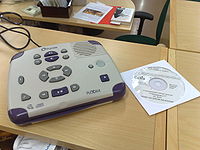DAISY audio book
DAISY is the name of a worldwide standard for navigable, accessible multimedia documents. The abbreviation DAISY stands for Digital Accessible Information System.
Both the older DAISY 2.02 standard and the ANSI / NISO standard Z39.86-2005 do not specify either the medium used or the sound standard. DAISY audio books are interactive. The DAISY consortium maintains a list of authoring systems.
Interactivity
The DAISY audio book offers comprehensive hierarchical navigation functions. The user can not only jump from chapter to chapter - he can jump over several hierarchy levels from chapter to page number to individual sentence or a footnote and back again.
The DAISY audio book offers a variety of display functions, as a pure audio book or, for example, as a full-text audio book. The user can always regulate the speaking speed - the voice does not change, its natural sound is retained. Texts and images can also be linked to the audio level.
The DAISY audio book offers intelligent editing functions. The user can place any number of bookmarks - the DAISY playback device shows the marked text passages again. With high-quality DAISY playback devices, the user can take notes on the text read.
Since 1999 there have been both hardware and software devices for the interactive use of information in the Daisy standard. The numerous performance features of DAISY can also be used on computers that are equipped with DAISY playback software.
history
In 1992 the Swedish library for the blind Talboks och Punktskriftsbiblioteket TPB began developing a first version of the DAISY standard for the DOS operating system . In May 1996, six national libraries for the blind founded the international DAISY consortium, which has since coordinated the development of the new audio book standard worldwide.
The DAISY standard has been supported by Microsoft since 2000 . In 2001 the first playback devices for digital audio books were presented, one each from the Japanese company Plextor and the Canadian company VisuAide, which now operates under the name HumanWare Group . (Product name: Victor).
Since 2002, libraries for the blind in Germany and Switzerland, Scandinavia and Great Britain as well as Japan, Canada and the USA have produced more than 128,000 DAISY audio books. These include u. a. the German Library for the Blind , the German Central Library for the Blind in Leipzig and the SBS Swiss Library for the Blind, the Visually Impaired and the Reading Disabled . For copyright reasons, these were initially not available in stores; the libraries for the blind are only allowed to lend them to their users. In September 2005, the first DAISY audio book in Europe was presented in bookshops in Zurich. Since August 2006, DAISY audio books have also been available for download in Germany for a fee. A comprehensive edition of “DAISYfied” audio books has been published on CD since autumn 2008, and these are also sold through retail and mail order bookshops.
Web links
- DAISY Consortium (English)
- Product tests and detailed information on DAISY playback devices in INCOBS
- DAISY website of the Swiss Library for the blind and visually impaired
- DAISY website of the German Central Library for the Blind in Leipzig
- Interview about DAISY in the BuchMarkt ( Memento from October 16, 2008 in the Internet Archive )
